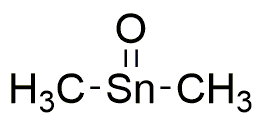Dimethyltin oxide is widely utilized in research focused on:
- Polymer Production: It serves as a catalyst in the synthesis of polyurethanes, enhancing the efficiency of the production process and improving the properties of the final product.
- Coatings and Sealants: This compound is used in the formulation of anti-fouling paints and coatings, providing excellent protection against marine organisms, which is crucial for the longevity of ships and marine structures.
- Pharmaceuticals: In medicinal chemistry, it acts as a precursor for organotin compounds that can be explored for therapeutic applications, particularly in cancer research.
- Environmental Applications: Dimethyltin oxide is involved in the development of biocides, which help in controlling unwanted microbial growth in various industrial processes, thus ensuring product integrity.
- Analytical Chemistry: It is utilized in the preparation of organotin standards for analytical methods, aiding in the accurate detection and quantification of tin compounds in environmental samples.
General Information
Properties
Safety and Regulations
Applications
Dimethyltin oxide is widely utilized in research focused on:
- Polymer Production: It serves as a catalyst in the synthesis of polyurethanes, enhancing the efficiency of the production process and improving the properties of the final product.
- Coatings and Sealants: This compound is used in the formulation of anti-fouling paints and coatings, providing excellent protection against marine organisms, which is crucial for the longevity of ships and marine structures.
- Pharmaceuticals: In medicinal chemistry, it acts as a precursor for organotin compounds that can be explored for therapeutic applications, particularly in cancer research.
- Environmental Applications: Dimethyltin oxide is involved in the development of biocides, which help in controlling unwanted microbial growth in various industrial processes, thus ensuring product integrity.
- Analytical Chemistry: It is utilized in the preparation of organotin standards for analytical methods, aiding in the accurate detection and quantification of tin compounds in environmental samples.
Documents
Safety Data Sheets (SDS)
The SDS provides comprehensive safety information on handling, storage, and disposal of the product.
Product Specification (PS)
The PS provides a comprehensive breakdown of the product’s properties, including chemical composition, physical state, purity, and storage requirements. It also details acceptable quality ranges and the product's intended applications.
Certificates of Analysis (COA)
Search for Certificates of Analysis (COA) by entering the products Lot Number. Lot and Batch Numbers can be found on a product’s label following the words ‘Lot’ or ‘Batch’.
*Catalog Number
*Lot Number
Certificates Of Origin (COO)
This COO confirms the country where the product was manufactured, and also details the materials and components used in it and whether it is derived from natural, synthetic, or other specific sources. This certificate may be required for customs, trade, and regulatory compliance.
*Catalog Number
*Lot Number
Safety Data Sheets (SDS)
The SDS provides comprehensive safety information on handling, storage, and disposal of the product.
DownloadProduct Specification (PS)
The PS provides a comprehensive breakdown of the product’s properties, including chemical composition, physical state, purity, and storage requirements. It also details acceptable quality ranges and the product's intended applications.
DownloadCertificates of Analysis (COA)
Search for Certificates of Analysis (COA) by entering the products Lot Number. Lot and Batch Numbers can be found on a product’s label following the words ‘Lot’ or ‘Batch’.
*Catalog Number
*Lot Number
Certificates Of Origin (COO)
This COO confirms the country where the product was manufactured, and also details the materials and components used in it and whether it is derived from natural, synthetic, or other specific sources. This certificate may be required for customs, trade, and regulatory compliance.


